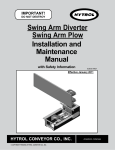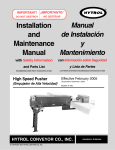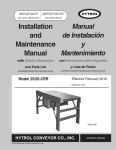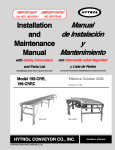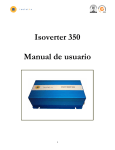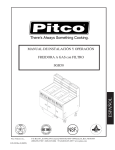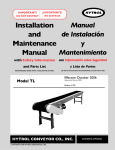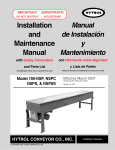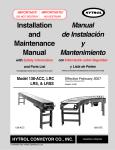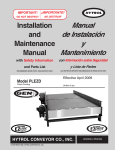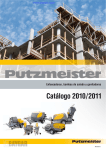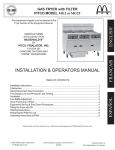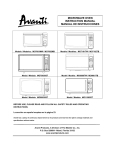Download Installation and Maintenance Manual
Transcript
IMPORTANT! ¡IMPORTANTE! DO NOT DESTROY NO DESTRUIR Manual Installation de Instalación and y Maintenance Mantenimiento Manual with Parts List con Lista de Partes RECOMMENDED SPARE PARTS HIGHLIGHTED IN GRAY LAS PARTES DE REPUESTO RECOMENDADAS SE RESALTAN EN GRIS Extenda Pusher Empujador Extenda Effective October 2010 Bulletin # 626 HYTROL CONVEYOR CO., INC. © COPYRIGHT PENDING–HYTROL CONVEYOR CO., INC. Jonesboro, Arkansas l Table of Contents l Tabla de Contenido INTRODUCTION Receiving and Uncrating . . . . . . . . . . . . . 3 INTRODUCCIÓN Recepción y Desembalaje . . . . . . . . . . . 3 INSTALLATION Assembly . . . . . . . . . . . . . . . . . . . . . . . 4, 5 Electrical Equipment . . . . . . . . . . . . . . . . 6 INSTALACIÓN Ensamble . . . . . . . . . . . . . . . . . . . . . . 4, 5 Equipo Eléctrico . . . . . . . . . . . . . . . . . . . 6 OPERATION Sequence of Operation . . . . . . . . . . . . 7, 9 Stroke Length/Proximity Switch Adjustment . . . . . . . . . . . . . . . . . . . . . 10 Speed (Main Air Pressure) Adjustment 11 OPERACIÓN Secuencia de Operación . . . . . . . . . . . 8, 9 Longitud de Carrera / Ajuste del Interruptor de Proximidad . . . . . . . . . . 10 Ajuste de Velocidad (Presión Principal de Aire ) . . . . . . . . . 11 MAINTENANCE Maintenance Precautions . . . . . . . . . . . Preventive Maintenance Checklist . . . . Trouble Shooting . . . . . . . . . . . . . . . . . . How to Order Replacement Parts . . . . . MANTENIMIENTO Medidas de Seguridad . . . . . . . . . . . . . Lista del Plan de Mantenimiento . . . . . . Resolviendo Problemas . . . . . . . . . . . . Como Ordenar Partes de Repuesto . . . PARTS DRAWINGS AND LIST Support Assembly Drawing . . . . . . . . . . Assembly Drawing - SA-039645 . . . . . Guide Kit - SA-046607 . . . . . . . . . . . . . Cylinder Kit - DG-001263 . . . . . . . . . . . Filter / Regulator Kit . . . . . . . . . . . . . . . 24VDC - DG-001262 120VAC - DG-001333 Valve Kit . . . . . . . . . . . . . . . . . . . . . . . . 24VDC - DG-001293 120VAC - DG-001335 Electrical Connections - 24VDC DG-001295 . . . . . . . . . . . . . . . . . . . . . Electrical Connections - 120VAC DG-001325 . . . . . . . . . . . . . . . . . . . . . 2 12 12 13 14 14 15 16 17 18 19 20 21 DIBUJO Y LISTA DE PARTES Dibujo de Ensamble del Soporte . . . . . Dibujo de Ensamble - SA-039645 . . . . Kit de la Guía - SA-046607 . . . . . . . . . . Kit del Cilindro - DG-001263 . . . . . . . . . Equipo Filtro/Regulador . . . . . . . . . . . . 24VCD - DG-001262 120VCA - DG-001333 Kit de Válvula - DG-001293 . . . . . . . . . 24VCD - DG-001293 120VCA - DG-001335 Conexiones Eléctricas - 24VCD DG-001295 . . . . . . . . . . . . . . . . . . . . . Conexiones Eléctricas - 120VCA DG-001325 . . . . . . . . . . . . . . . . . . . . . 12 12 13 14 14 15 16 17 18 19 20 21 INTRODUCTION INTRODUCCIÓN This manual provides guidelines and procedures for installing, operating, and maintaining your Extenda Pusher. A complete parts list is provided with recommended spare parts highlighted in gray. Important safety information is also provided throughout the manual. Este manual provee las pautas y los procedimientos para instalar, operar y mantener su empujador Extenda. Se proporciona una lista completa de partes, con partes de repuesto recomendadas que se resaltan en gris. También se proporciona información importante de seguridad a lo largo de este manual. For safety to personnel and for proper operation of your pusher, it is recommended that you read and follow the instructions provided in this manual. Para seguridad del personal y para un funcionamiento apropiado del empujador, se recomienda que lean y sigan las instrucciones proporcionadas en este manual. l Receiving and l Recepción y Uncrating Desembalaje 1. . . Check the number of items received against the bill of lading. 2. . . Examine condition of equipment to determine if any damage occurred during shipment. 3. . . Move all crates to area of installation. 4. . . Remove crating and check for optional equipment that may be fastened to the equipment. Make sure these parts (or any foreign pieces) are removed. 1. . . Verifique el número de partes recibidas con respecto al conocimiento de embarque. 2. . . Examine las condiciones del equipo con el fin de determinar si algún daño ha ocurrido durante el transporte. 3. . . Traslade todo el equipo al área de instalación. 4. . . Remueva todos los empaques y verifique si hay partes opcionales que puedan estar atadas al equipo. Asegúrese de que estas partes (u otras partes externas) sean removidas. NOTE: If damage has occurred or freight is missing, see the “Important Notice” attached to the crate. NOTA: Si algún daño ha ocurrido o falta cargamento, vea las “Notas Importantes” adheridas al embalaje. Inspection Notes: Notas de Inspección: 3 INSTALLATION l Assembly l Ensamble The Extenda Pusher comes completely assembled except for installing supports, connecting air and electrical supply, and mounting to conveyor. El Empujador Extenda viene completamente ensamblado con excepción de los soportes, las conexiones a las fuentes eléctricas y de aire, y el montaje al transportador. If pusher is to be mounted to a new conveyor, install conveyor as described in the installation and maintenance manual for the conveyor. Si el Empujador va a ser instalado en un transportador nuevo, instale el transportador como se describe en su propio manual de instalación y mantenimiento. Instructions for installing the pusher are as follows: MOUNTING TO CONVEYOR Las instrucciones para instalar el empujador son las siguientes: MONTAJE AL TRANSPORTADOR 1. . . Determine location of the Extenda Pusher by finding center line of take-away conveyor. (Figure 5A) 2. . . Fasten K-Brackets to conveyor frame as shown in (Figure 5B). NOTE: If pusher is mounting to bed type conveyor, the K-Brackets are not required. 3. . . Attach supports to center leg attachment angle and support angle. (Figure 5C) 4. . . Set pusher in place with bottom of ram face located 1/4 inch min. above conveying surface with 3/8 inch bolts. (Figure 5B) 5. . . Lag supports to floor. (Figure 5C) 1. . . Encuentre la línea central del transportador receptor de paquetes para determinar la ubicación del empujador. (Figura 5A). 2. . . Asugure las ménsulas tipo K al canal del transportador como se muestra en la Figura 5B. NOTA: Si el empujador es instalado en un transportador de cama, no se requieren las ménsulas tipo K. 3. . . Fije los soportes al ángulo de acoplamiento de soporte central y al ángulo del soporte (Figura 5C). 4. . . Fije el empujador en su lugar con pernos de 3/8 de pulgada, ubicando la parte inferior de la cara del brazo a mínimo 1/4 de pulgada sobre la superficie del transportador (Figura 5B). 5. . . Fije los soportes al piso (Figura 5C). AIR SUPPLY SUMINISTRO DE AIRE 6. . . Connect main air line to Filter Regulator. (Figure 5A). 7. . . Set working pressure on regulator as described in the speed adjustment (main air) instructions on Page 11. NOTE: See Packing Envelope for maintenance instructions on How To Adjust and Lubricate the FRL. ELECTRICAL 8. . . Install electrical controls and connect to control boxes. See Pages 6 , 20 and 21. 4 INSTALACIÓN 6. . . Conecte la línea principal de aire al Filtro Regulador (Figura 5A). 7. . . Fije la presión de trabajo en el regulador principal como se describe en las instrucciones de ajuste de velocidad (suministro principal de aire) en la Página 11. Nota: Vea el Sobre de Empaque para instrucciones de mantenimiento sobre Como Ajustar y Lubricar el FRL. ELÉCTRICOS 8. . . Instale los controles eléctricos y conéctelos a las cajas de controles. Vea páginas 6 , 20 y 21. Figure 5A (Figura 5A) (Empujador Extenda) (Retraído) Extenda Pusher (Retracted) (Filtro/Regulador) Filter Regulator Center Line (Línea Central) Center Line (Línea Central) Main Air Supply (Suministro Principal de Aire) Take-Away Conveyor (Transportador Receptor) Figure 5B (Figura 5B) 1/4 in. K-Bracket (Ménsula tipo K) Conveyor Frame (Canal del Tranportador) Extenda Pusher (Retracted) (Empujador Extenda) (Retraído) Main Air In (Suministro Principal de Aire) Figure 5C (Empujador Extenda) (Figura 5C) (Extendido) Extenda Pusher (Extended) Pusher Base (Base del Empujador) Attach Supports Lag to Floor (Typ 4 Plcs) (Fijar al piso) (Typ Both Sides) (Fijar los Soportes) (en dos lados generalmente) (en cuatro lugares generalmente) Attach Supports (Typ Both Sides) (Fijar los Soportes) (en dos lados generalmente) 5 l Electrical Equipment WARNING! Electrical controls shall be installed and wired by a qualified electrician. Wiring information for the controls are furnished by the equipment manufacturer. ¡ADVERTENCIA! Los controles eléctricos deben ser conectados e instalados por un electricista calificado. La información sobre el cableado de los controles será proporcionada por el fabricante del equipo. CONTROLS CONTROLES Electrical Code: All motor controls and wiring shall conform to the National Electrical Code (Article 670 or other applicable articles) as published by the National Fire Protection Association and as approved by the American Standards Institute, Inc. Código Eléctrico: Todo Equipo Eléctrico y las conexiones deben ajustarse al “National Electrical Code” (Artículo 670 u otros artículos aplicables) como fue publicado por la “National Fire Protection Association” y aprobado por el “American Standards Institute, Inc”. CONTROL STATIONS ESTACIONES DE CONTROL A) Control stations should be so arranged and located that the operation of the equipment is visible from them, and shall be clearly marked or labeled to indicate the function controlled. A) Las estaciones de control deberán estar arregladas y ubicadas en lugares donde el funcionamiento del equipo sea visible y deberán estar claramente marcadas o señaladas para indicar la función controlada. SAFETY DEVICES DISPOSITIVOS DE SEGURIDAD A) All safety devices, including wiring of electrical safety devices, shall be arranged to operate in a “Fail-Safe” manner, that is, if power failure or failure of the device itself would occur, a hazardous condition must not result. A) Todos los dispositivos de seguridad, incluyendo la conexión de dispositivos eléctricos, deben estar dispuestos para operar en una manera de “autoprotección”; es decir, si se presenta una pérdida de corriente o un fallo en el mismo dispositivo, esto no debe resultar en una situación peligrosa. B) Emergency Stops and Restarts. Conveyor controls shall be so arranged that, in case of an emergency stop, manual reset or start at the location where the emergency stop was initiated, shall be required of the conveyor(s) and associated equipment to resume operation. C) Before restarting a conveyor which has been stopped because of an emergency, an inspection of the conveyor shall be made and the cause of the stoppage determined. The starting device shall be locked out before any attempt is made to remove the cause of stoppage, unless operation is necessary to determine the cause or to safely remove the stoppage. Refer to ANSI Z244.1-1982, American National Standard for Personnel Protection – Lockout/Tagout of Energy Sources – Minimum Safety Requirements and OSHA Standard Number 29 CFR 1910.147 “The Control of Hazardous Energy (Lockout/Tagout).” 6 l Equipo Eléctrico B) Paradas de Emergencia y Reactivadores. Los controles del transportador deberán estar dispuestos de tal manera que, en caso de una parada de emergencia, se requiera un activador o un arrancador manual en el lugar donde la parada de emergencia se presente para reanudar la operación del transportador o transportadores y el equipo asociado. C) Antes de reiniciar un transportador que ha sido detenido por una emergencia, debe realizarse una revisión del transportador y determinarse la causa de la parada. El dispositivo de arranque deberá ser bloqueado antes de intentar corregir el problema, a no ser que la operación del transportador sea necesaria para determinar la causa de la parada o para solucionar el problema. Refiérase al ANSI Z244.1-1982, American National Standard for Personnel Protection - Lockout/Tagout of Energy Sources - Minimum Safety Requirements and OSHA Standard Number 29 CFR 1910.147 “The Control of Hazardous Energy (Lockout/Tagout).” OPERATION l Sequence of Operation The Extenda Pusher is comprised of a number of pneumatic and electrical parts to sense the position of the ram. One cycle of the pusher is described in the following sequence. Reference Page 9 (Figure 9A) 1. . . RAM FULLY RETRACTED When the pusher is in the stand-by mode (retracted), air is supplied through the air valve, port-B to the retract end of the cylinders, holding the ram in the retracted position. The P2 proximity switch, home position sensor, is activated. 2. . . SIGNAL TO BEGIN CYCLE Contact “X” is closed momentarily. (This is the signal from a photo-eye, programmable controller, etc., to activate the pusher.) The solenoid is energized which shifts air to the valve, Port-A, sending air to the extend end of the cylinders to begin the cycle. As the ram extends, P2 home proximity switch is de-activated. NOTE: The length of time for that signal needs to be long enough to clear the home proximity switch. 3. . . BEGINNING OF RETRACT STROKE As the ram nears the end of the extend stroke, it activates P1, the extend proximity switch, which in turn activates the solenoid, Port-B, of the air valve. Air is shifted from the extend end of the cylinders to the retract end, causing the ram to begin the retract stroke. (The ram is reversed before the cylinder is fully extended to cushion the stroke.) 4. . . END OF RETRACT STROKE As the ram approaches the end of the retract stroke, it activates P1, which in turn activates the solenoid, Port-A of the air valve. This sends a burst of air into the extend end of the cylinder, cushioning the impact of the ram as it returns to the fully retracted position. NOTE: Some of the cushion air is allowed to exhaust through the air valve and through a flow control valve, which allows the cushioning action to be adjusted for proper operation. (See Figure 19A) NOTE: The above sequence is for the pusher as it is wired at the factory. (See Wiring Diagram on Pages 20 and 21 (Figure 20A and 21A). CAUTION! The activation signal must be off before the extend proximity switch is cleared. A longer signal will override the retract signal given by the extend prox, allowing the ram to over extend and “bottom-out”, possibly damaging the cylinder. 7 OPERACIÓN l Secuencia de Operación El empujador Extenda está compuesto de un número de partes neumáticas y eléctricas para percibir la posición del brazo. La siguiente secuencia describe un ciclo del empujador. Refiérase a la Página 9. (Figura 9A) 1. . . BRAZO TOTALMENTE RETRAÍDO Cuando el empujador está en el modo stand-by (retraído), se suministra aire a través de la válvula de aire (Puerto B), al extremo retractor de los cilindros, manteniendo así el brazo en posición de retracción. El interruptor de proximidad P2, sensor de la posición de retracción, es activado. 2. . . SEÑAL PARA COMENZAR EL CICLO El contacto “X” se cierra momentáneamente. (Ésta es la señal de la fotocelda, del controlador programable, etc., para activar el empujador). El solenoide recibe energía transfiriendo aire a la válvula (Puerto A) y enviando aire al extremo extensor de los cilindros para comenzar el ciclo. A medida que el brazo se extiende, el interruptor de proximidad P2 es desactivado. NOTA: El periodo de tiempo para esta señal debe ser lo suficientemente largo para desactivar el interruptor de proximidad. 3. . . INICIO DE LA CARRERA DE RETRACCIÓN A medida que el brazo se aproxima al final de la carrera de extensión, éste activa P1 el interruptor de proximidad de extensión, el cual activa a su vez el solenoide (Puerto B) de la válvula de aire. El aire se transfiere del extremo extensor de los cilindros al extremo retractor, causando que el brazo comience la carrera de retracción. (El brazo da marcha atrás antes de que el cilindro se extienda totalmente para amortiguar la carrera.) 4. . . FINAL DE LA CARRERA RETRACCIÓN A medida que el brazo se aproxima al final de la carrera de retracción, esté activa P1, el cual activa a su vez el solenoide (Puerto A) de la válvula de aire. Ésto envía una ráfaga de aire dentro del extremo extensor del cilindro, amortiguando el impacto del brazo a medida que éste vuelve a la posición de total retracción. NOTA: Parte del aire de amortiguación escapa a través de la válvula de aire y de la válvula de control de flujo, lo cual permite que la acción de amortiguación sea ajustada para una operación apropiada. (Refiérase a la Figura 19A). NOTA: La secuencia anterior es para el empujador cuya conexión ha sido hecha en la fábrica. (Vea el Diagrama de Conexión de las Páginas 20 y 21, Figuras 20A y 21A). ¡CUIDADO! La señal de activación debe estar apagada antes de que el interruptor de proximidad de extensión sea desactivado. Una señal de activación de larga duración puede anular la señal de retracción dada por el interruptor de proximidad de extensión, haciendo con que el brazo se sobre extienda causando un posible daño en el cilindro. 8 l Ram Fully Retracted (Brazo Completamente Retraído) Figure 9A (Figura 9A) Ram Face Válvula de Aire Air Valve (Cara del Brazo) B A Sensor Bar (Barra Sensora) Extend Prox P1 (Interruptor de Prox. de Extensión P1) Flow Control Valves Home Prox P2 (Interruptor de Prox. P2) (Válvulas de Control de Flujo) Ram (Brazo) Air Cylinders (Cilindros de Aire) Filter/Regulator (Filtro/Regulador) Main Air Supply (Suministro Principal de Aire) Extend Prox P1 (Interruptor de Prox. de Extensión P1) Air Valve Sensor Bar (Válvula de Aire) (Barra Sensora) Home Prox P2 (Interruptor de Prox. P2) Filter / Regulator with E-Stop (Filtro/Regulador con Parada de Emergencia) 9 lStroke Length/Proximity lLongitud de Carrera / Ajuste The Extenda Pusher is available in four stroke lengths: 16”, 22”, 28” and 34”. The stroke length may be set at any point within the range of each model. Stroke may be varied by adjusting the extend proximity switch (P1). This procedure, as well as other adjustments required to set the proximity switches, are described below. El Empujador Extenda está disponible en cuatro rangos de longitud de carrera: 16”, 22”, 28” y 34”. La longitud de carrera se puede fijar en cualquier punto dentro del rango de cada modelo. La carrera se puede modificar mediante el ajuste del interruptor de proximidad de extensión (P1). Este procedimiento, como otros ajustes requeridos en los interruptores de proximidad, se describen a continuación. AJUSTE DE LA LONGITUD DE CARRERA (P1) 1. . . Afloje un poco los tornillos de la placa de montaje del interruptor. (Figura 10AA) 2. . . Deslice el interruptor en las ranuras de la cama del empujador para ajustar la carrera: hacia el transportador para aumentar la carrera y alejándose del transportador para disminuirla. (Figura 10A) 3. . . Revise el ajuste de la carrera colocando el empujador en marcha por un ciclo. Si se requiere un ajuste adicional, repita el paso 2. 4. . . Apriete los tornillos de la placa de montaje del interruptor. (Figura 10AA) Switch Adjustment STROKE LENGTH ADJUSTMENT (P1) 1. . . Loosen the switch mounting nuts slightly. (Figure 10AA). 2. . . Slide the switch in the slots in the pusher bed to adjust stroke: toward conveyor to increase stroke, away from conveyor to decrease. (Figure 10A) 3. . . Check the stroke setting by cycling the pusher. If further adjustment is needed, repeat Step 2. 4. . . Tighten the switch mounting nuts. (Figure 10AA) HOME PROXIMITY SWITCH ADJUSTMENT (P2) 1. . . If the Home Proximity Switch needs adjustment, follow steps 1 through 4 above. del Interruptor de Proximidad ADJUSTE DEL INTERRUPTOR DE PROXIMIDAD (P2) 1. . . Si el interruptor de proximidad requiere ajuste, siga los pasos del 1 al 4 mencionados anteriormente. Figure 10A Mounting Nuts (Figura 10A) Adjustment Slot (Tornillos de Montaje) Inc re (Ranura de ajuste) as eS Figure 10AA tro ke (Figura 10AA) (P1) Prox Switch (Interruptor de Proximidad) Pusher Base (Base del Empujador) (P2) Adjustment Slot (Ranura de ajuste) VERTICAL ADJUSTMENT (ALL SWITCHES) 1. . . Close air supply valve and disconnect power supply. Remove plastic guards. NOTE: The guard is held in place by 4 fasteners. (Figure 11A) 2. . . Manually position the ram so that the sensor bar is directly above the switch. 3. . . Loosen the jam nuts on the switch.(Figure 10AA) Position the switch so that there is a 1/4” gap between the switch and the sensor bar. (Figure 11A). Tighten the jam nuts securely. 10 AJUSTE VERTICAL (TODOS LOS INTERRUPTORES) 1. . . Cierre la válvula de aire y desconecte la fuente de poder. Remueva la guardas plásticas.NOTA:La guarda se ajusta en su lugar con cuatro aseguradores (Figura 11A). 2. . . Posicione manualmente el brazo de manera que la barra sensora quede directamente sobre el interruptor. 3. . . Afloje las contratuercas del interruptor. (Figura 10AA) Posicione el interruptor de manera que quede un espacio de 1/4” entre el interruptor y la barra sensora. (Figura 11A). Apriete las contratuercas firmemente. Figure 11A (Figura 11A) Plastic Guard (Guarda Plástica) Prox Switch (Interruptor de Prox) Sensor Bar (Barra Sensora) 1/4 inch Cover Fasteners (Typ. Both Sides) (Aseguradores de la Cubierta) (Generalmente en dos Lados) l Speed (Main Air Pressure) Adjustment l Ajuste de Velocidad (Presión Principal de Aire) Pusher speed (cycle time) will vary depending on the weight of the product being pushed. However, speed (and impact force) may be controlled by adjusting the main pressure regulator. The following procedure is suggested to set the proper operating pressure for your particular range of product weights. NOTE: Flow Control Valve may require adjustment after main pressure change. La velocidad del empujador (tiempo del ciclo) puede variar dependiendo del peso del producto a ser empujado. Sin embargo, la velocidad (y la fuerza del impacto) se puede controlar ajustando el regulador de presión principal. Se recomienda el siguiente procedimiento para establecer la presión de operación apropiada para el rango específico de peso de sus productos. NOTA: Si la presión principal cambia, la válvula de control de flujo puede requerir ajuste. IF YOUR PRODUCT WEIGHT IS CONSISTENT (± 5 lbs.): 1. . . Set pressure at 80 PSI and adjust as needed. 2. . . Place product on conveyor and operate pusher. a) If pusher “throws” product or causes product to tumble, decrease pressure approximately 10 PSI, and adjust flow control valve Port A to decrease air flow and repeat test. Port B is typically opened to maximum setting. (Figure 9A) b) Repeat until desired pushing action is achieved. NOTE: Recommended pressure range: 60 to 80 PSI. IF YOUR PRODUCT WEIGHT VARIES CONSIDERABLY: 1. . . Set pressure at 80 PSI and adjust as needed. 2. . . Select heaviest product and set pressure as described in Step 2 above. Select the lowest pressure that will push the product at the required speed. 3. . . Select the lightest product and test. If pushing action is unacceptable: a) If possible, decrease the difference in product weights. (This applies to order picking operations using totes, etc.) b) Vary main pressure as described above to find the pressure that works best for most product weights. SI EL PESO DE SU PRODUCTO ES CONSISTENTE (± 5 lbs.): 1. . . Fije la presión en 80 PSI y ajuste como sea necesario. 2. . . Coloque el producto sobre el transportador y opere el empujador. a) Si el empujador “arroja” el producto o provoca que el producto ruede, disminuya la presión 10 PSI aproximadamente, ajuste la válvula de control de flujo (Puerto A) para disminuir el flujo de aire y repita la prueba. Generalmente, el (Puerto B) está completamente abierto en el máximo nivel. (Figura 9A) b) Repita hasta que se obtenga la acción de empuje deseada. NOTA: Rango de presión recomendado: 60 a 80 PSI. SI EL PESO DEL PRODUCTO VARIA CONSIDERABLEMENTE 1. . . Fije la presión en 80 PSI y ajuste como sea necesario. 2. . . Seleccione el producto más pesado y fije la presión como se ha descrito previamente en el Paso 2. Seleccione la presión más baja que empuje el producto a la velocidad requerida. 3. . . Seleccione el producto más liviano y pruebe. Si la acción de empuje es inaceptable: a) Si es posible, disminuya la diferencia de peso entre productos. (Esto aplica en operaciones de selección de ordenes usando contenedores plásticos, etc.) b) Ajuste la presión principal como se describe previamente para encontrar la presión que funcione mejor con la mayoría de pesos de los productos. 11 MAINTENANCE l Maintenance Precautions MANTENIMIENTO l Medidas en el Mantenimiento A) Maintenance, such as lubrication and adjustments shall be performed only by qualified and trained personnel. A) El mantenimiento, tal como lubricación y ajustes, deberá B) It is important that a maintenance program be established to insure that all conveyor components are maintained in a condition which does not constitute a hazard to personnel. B) Es importante que se establezca un programa de mantenimiento para asegurar que todos los componentes del transportador sean mantenidos en condiciones que no constituyan un peligro para el personal. C) When a conveyor is stopped for maintenace purposes, starting devices or powered accessories shall be locked or tagged out in accordance with a formalized procedure designed to protect all persons involved with the conveyor against an unexpected start. Reference (Figure 18A). D) Replace all safety devices and guards before starting equipment for normal operation. E) Whenever practical, DO NOT lubricate conveyors while they are in motion. Only trained personnel aware of the hazard of the conveyor in motion shall be allowed to lubricate. Safety Guards Maintain all guards and safety devices IN POSITION and IN SAFE REPAIR. Warning Signs Maintain all warning signs in legible condition and obey all warnings. See SAFETY MANUAL for examples of warning signs ser realizado solamente por personal calificado y entrenado. C) Cuando un transportador esta parado por razones de mantenimiento, los dispositivos de arranque o accesorios motorizados deberán ser asegurados o desconectados conforme a un procedimiento formalizado, diseñado para proteger a toda persona o grupos involucrados con el transportador de un arranque inesperado. (Figura 18A) D) Antes de poner en marcha el equipo en una operación normal, vuelva a colocar todos los dispositivos de seguridad y las guardas. E) Siempre que sea práctico, NO lubrique los transportadores mientras se encuentren en movimiento. Solo el personal entrenado que tenga conocimiento de los peligros del transportador en movimiento, se le permitirá hacer la lubricación. Protecciones De Seguridad Mantenga todas las guardas y dispositivos de seguridad EN SU POSICIÓN y EN BUENAS CONDICIONES. Señales De Advertencia Mantenga todas las señales de advertencia en buenas condiciones y obedézcalas. Remítase a la “SAFETY MANUAL” para ver ejemplos de señales de advertencia. l Preventive Maintenance l Lista del Plan de DAILY 1. . . Check air pressure in regulator, See Instructions on DIARIAMENTE Checklist Page 11. 2. . . Check for water in filter bowl. Drain when water level reaches the lower baffle. 3. . . Check for excessive noise or vibration during operation. WEEKLY 1. . . Check cylinder rod for dirt build-up. Clean as needed. MONTHLY 1. . . Check ram guides for wear. Clean off excess dirt buildup. 12 Mantenimiento 1. . . Revise la presión de aire en el regulador. Vea instrucciones en la Página 11. 2. . . Revise el agua en el recipiente del filtro. Vacíe cuando el nivel del agua alcance el punto más bajo del desviador. 3. . . Revise si se produce ruido o vibración excesiva durante la operación. SEMANALMENTE 1. . . Revise si se ha acumulado suciedad en la barra del cilindro. Limpie si es necesario. MENSUALMENTE 1. . . Revise si se han desgastado las guías del brazo. Retire la suciedad que se haya acumulado. l Trouble Shooting TROUBLE Pusher will not activate. SOLUTION CAUSE 1) No power to pusher 2) Air loss to pusher 3) No activation signal to pusher Pusher stroke too long or hits hard on extend 1) Extend proximity switch too close to front stroke. of pusher 2) Activation signal too long 1) Check power source. 2) Check air supply. 3) Check signal source. 1) Adjust proximity switch. (See Page 10). 2) Decrease activation signal time. (200 milliseconds maximum). Pusher stroke too short. 1) Extend proximity switch too close to rear of pusher 1) Adjust proximity switch. (See Page 10). Little or no cushion on retract stroke. 1) Cushion “bleed-off” needs adjustment 2) Home proximity switch out of adjustment 1) Adjust cushion “bleed-off”. (See Page 11). 2) Adjust proximity switch. (See Page 10). Ram “bounces” at end of retract stroke or 1) Cushion “bleed-off” needs adjustment remains partially extended. 1) Adjust cushion “bleed-off”. (See Page 11). Pusher is sluggish; may not push product. 1) Adjust main regulator. (See Page 11). 1) Main regulator pressure too low Pusher hits hard in both directions, may hit 1) Main regulator pressure too high package too hard. 1) Adjust main regulator. (See Page 11). Ram extends completely, hits hard, and 1) Extend proximity switch out of adjustment remains extended. 2) Extend signal excessive 1) Adjust proximity switch. (See Page 10). 2) Adjust signal duration l Resolviendo Problemas PROBLEMA CAUSA SOLUCIÓN El empujador no se activa. 1) El empujador no recibe poder. 2) Pérdida de aire al empujador. 3)No hay señal de activación al empujador. 1) Revise la fuente de poder. 2) Revise la fuente de aire. 3) Revise el origen de la señal. La carrera del empujador es demasiado larga o golpea fuerte en la carrera de extensión. 1) El interruptor de proximidad del extensor está demasiado cerca a la parte delantera del empujador. 2)La señal de activación es demasiado larga. 1) Ajuste el interruptor de proximidad. (Ver Pág. 10). La carrera del empujador es demasiado corta. 1) El Interruptor de proximidad del extensor está demasiado cerca a la parte trasera del empujador. 1) Ajuste el interruptor de proximidad. (Ver Pág. 10). Poco o nada de amortiguación en la carrera de retracción. 1) La descarga de amortiguación necesita ajuste. 2) El Interruptor de Proximidad está desajustado 1) Ajuste la descarga de amortiguación. (Ver Pág. 11) Brazo “rebota” al final de la carrera de retracción o permanece parcialmente extendido. 1) La descarga de amortiguación necesita ajuste. 1) Ajuste la descarga de amortiguación. (Ver Pág. 11) El empujador está lento; no empuja el producto. 1) La presión del regulador principal es demasiado baja. 1) Ajuste el regulador principal. (Ver Pág. 11) El empujador golpea fuerte en ambas direcciones. Puede golpear el producto demasiado fuerte. 1) La presión del regulador principal es demasiado alta. 1) Ajuste el regulador principal. (Ver Pág. 11) El brazo se extiende completamente, golpea fuerte y permanece extendido. 1) El interruptor de proximidad de extensión está desajustado. 2) Señal de extensión excesiva. 1) Ajuste el interruptor de proximidad. (Ver Pág. 10) 2) Disminuya el tiempo de activación de la señal. (200 milisegundos máx.) 2) Ajuste el Interruptor de Proximidad. (Ver Pág. 10) 2) Ajuste la duración de las señal de extensión. 13 l How to Order l Como Ordenar Included in this manual is a parts drawing with a complete replacement parts list. When ordering replacement parts, please refer to the ordering procedure below: Dibujos de las partes y listas completas de las partes de repuesto están incluidos en este manual. Cuando ordene partes de repuesto, por favor refiérase al siguiente procedimiento: 1. . . Contact Distributor from which equipment was originally purchased or nearest HYTROL Distributor. 2. . . Provide Distributor with the model and the part description and number from Parts List. 3. . . Advise if you are in a breakdown situation, so expedited service is provided. 1. . . Contacte al Distribuidor que le vendió el equipo Partes de Repuesto Replacement Parts originalmente o al distribuidor de Hytrol más cercano. 2. . . Proporcione al Distribuidor el modelo y la descripción de la parte y el número que aparece en la Lista de Partes. 3. . . Informe si se encuentra en una situación crítica para prestarle el servicio lo más rápido posible. lSupport Assembly Drawing (Dibujo de Ensamble de Soporte) Figure 14A (Figura 14A) A Mounting Holes PW = Extenda Pusher Width (Ancho del Empujador Extenda) (Huecos de Montaje) FH = Support Frame Height (Altura de Estructura del Soporte) A = Support Frame Width (Ancho de Estructura del Soporte) B = Dist. Floor to Top Mount Hole (Dist. del Piso al Tope del Hueco de Montaje) C = Foot Assembly Height (Altura del Ensamble del Pie del Soporte) 14 PW FH A B C ITEM #1 ITEM #2 18 in. 24 in. 30 in. 36 in. 6 in. 6 in. 6 in. 6 in. 20 in. 23 in. 26 in. 29 in. 6-7/8 in. to 9-7/8 in. 6-7/8 in. to 9-7/8 in. 6-7/8 in. to 9-7/8 in. 6-7/8 in. to 9-7/8 in. 5-1/8 in. 5-1/8 in. 5-1/8 in. 5-1/8 in. G-00609-020 G-00609-023 G-00609-026 G-00609-029 G-00611 G-00611 G-00611 G-00611 18 in. 24 in. 30 in. 36 in. 9 in. 9 in. 9 in. 9 in. 20 in. 23 in. 26 in. 29 in. 9-7/8 in. to 12-7/8 in. 9-7/8 in. to 12-7/8 in. 9-7/8 in. to 12-7/8 in. 9-7/8 in. to 12-7/8 in. 7-1/4 in. 7-1/4 in. 7-1/4 in. 7-1/4 in. G-00610-020 G-00610-023 G-00610-026 G-00610-029 G-00613 G-00613 G-00613 G-00613 18 in. 24 in. 30 in. 36 in. 12 in. 12 in. 12 in. 12 in. 20 in. 23 in. 26 in. 29 in. 12-7/8 in. to 15-7/8 in. 12-7/8 in. to 15-7/8 in. 12-7/8 in. to 15-7/8 in. 12-7/8 in. to 15-7/8 in. 7-1/4 in. 7-1/4 in. 7-1/4 in. 7-1/4 in. G-00616-020 G-00616-023 G-00616-026 G-00616-029 G-00613 G-00613 G-00613 G-00613 18 in. 24 in. 30 in. 36 in. 15 in. 15 in. 15 in. 15 in. 20 in. 23 in. 26 in. 29 in. 15-7/8 in. to 18-7/8 in. 15-7/8 in. to 18-7/8 in. 15-7/8 in. to 18-7/8 in. 15-7/8 in. to 18-7/8 in. 7-1/4 in. 7-1/4 in. 7-1/4 in. 7-1/4 in. G-00617-020 G-00617-023 G-00617-026 G-00617-029 G-00613 G-00613 G-00613 G-00613 18 in. 24 in. 30 in. 36 in. 18 in. 18 in. 18 in. 18 in. 20 in. 23 in. 26 in. 29 in. 18-7/8 in. to 24-7/8 in. 18-7/8 in. to 24-7/8 in. 18-7/8 in. to 24-7/8 in. 18-7/8 in. to 24-7/8 in. 10-1/4 in. 10-1/4 in. 10-1/4 in. 10-1/4 in. G-00618-020 G-00618-023 G-00618-026 G-00618-029 G-00614 G-00614 G-00614 G-00614 18 in. 24 in. 30 in. 36 in. 24 in. 24 in. 24 in. 24 in. 20 in. 23 in. 26 in. 29 in. 24-7/8 in. to 30-7/8 in. 24-7/8 in. to 30-7/8 in. 24-7/8 in. to 30-7/8 in. 24-7/8 in. to 30-7/8 in. 10-1/4 in. 10-1/4 in. 10-1/4 in. 10-1/4 in. G-00619-020 G-00619-023 G-00619-026 G-00619-029 G-00614 G-00614 G-00614 G-00614 18 in. 24 in. 30 in. 36 in. 30 in. 30 in. 30 in. 30 in. 20 in. 23 in. 26 in. 29 in. 30-7/8 in. to 42-7/8 in. 30-7/8 in. to 42-7/8 in. 30-7/8 in. to 42-7/8 in. 30-7/8 in. to 42-7/8 in. 18-3/8 in. 18-3/8 in. 18-3/8 in. 18-3/8 in. G-00620-020 G-00620-023 G-00620-026 G-00620-029 G-00615 G-00615 G-00615 G-00615 FH B C 5/8 Min. Frame Assembly (Ensamble de la Estructura) 1 2 Foot Assembly (Ensamble del Pie) ITEM QTY DESCRIPTION PART NUMBER 1 1 HS SUPT FRAME WELDMENT SEE CHART 2 2 HS FOOT WELDMENT SEE CHART PARTS DRAWING AND LIST (DIBUJO y LISTA de PARTES) l Assembly Drawing - SA-039645 (Dibujo de Ensamble) Figure 15A (Figura 15A) 9 (Not Shown) 10 25 24 REF # 1 2 3 ----4 ----5 ----6 --7 ----8 --- PART # 092.1639 923.0089 -928.00291 928.029 928.00292 928.00293 -928.00301 928.0030 928.00302 928.00303 -928.00311 928.0031 928.00312 928.00313 -DG-001262 DG-001333 -DG-001263-018 DG-001263-024 DG-001263-030 DG-001263-036 -DG-001293 DG-001335 DESCRIPTION Rubber Vibration Mount - 3/4 in. Dia. X 3/8 in. Thick Bumper Primary Guard (Specify Stroke) 16 in. Stroke 22 in. Stroke 28 in. Stroke 34 in. Stroke Secondary Guard (Specify Stroke) 16 in. Stroke 22 in. Stroke 28 in. Stroke 34 in. Stroke Base Guard (Specify Stroke) 16 in. Stroke 22 in. Stroke 28 in. Stroke 34 in. Stroke Filter Regulator Kit 24VDC 120VAC Cylinder Kit (Specify Stroke) 16 in. Stroke 22 in. Stroke 28 in. Stroke 34 in. Stroke Valve Kit 24VDC 120VAC REF # 9 --10 11 12 13 14 15 16 17 18 19 ----20 21 ----22 23 24 25 PART # -DG-001295 DG-001325 G-00571 PT-103684 PT-103685 PT-103687 PT-103699 PT-105363 PT-105726 PT-108204 PT-108723 -SA-046607-018 SA-046607-024 SA-046607-030 SA-046607-036 WA-030921 -WA-030922-018 WA-030922-024 WA-030922-030 WA-030922-036 091.109 094.1141 See Page 14 See Page 14 DESCRIPTION Electrical Connections 24VDC 120VAC K-Bracket (Specify Conveyor Model) Valve Mounting Bracket (Hidden) Primary Ram Channel Secondary Ram Channel Valve Cover Ram Face - 8 in. x 24 in. Cylinder Block Center Leg Attachment Angle Support Angle Guide Kit (Specify Stroke) 16 in. Stroke 22 in. Stroke 28 in. Stroke 34 in. Stroke Rear Secondary Brace Weldment Base Weldment (Specify Stroke) 16 in. Stroke 22 in. Stroke 28 in. Stroke 34 in. Stroke Cable Tie - 5-1/2 in. Long (Not Shown) Push Button (Not Shown) Support Frame Weldment (Specify Stroke) Support Foot Weldment 15 l Guide Kit - SA-046607 (Kit de la Guía) Figure 16A (Figura 16A) 6 Aluminum Profile (Perfil de Aluminio) 1 Aluminum Profile (Perfil de Aluminio) Linear Bearing (Cojinete Linear) 3 Sensor Bar (Barra Sensora) 2 4 7 5 UHMW Guide (Guia UHMW) See Page 14 for Information on How to Order Replacement Parts Vea la Página 14 para Información sobre Como Ordenar Partes de Repuesto Recommended Spare Parts highlighted in Gray Las Partes de Repuesto Recomendadas se Resaltan en Gris 16 Ref. No. 1 2 3 4 ----5 ----- Part No. 096.115 928.0012 928.0014 -928.00261 928.0026 928.0010 928.00263 -928.00281 928.0028 928.0019 928.00282 Description Locktite Double Flange Linear Bearing T-Nut - 1/4-20 Aluminum Profile - 1530 T-Slotted 17-1/4 in. Long - 16 in. Stroke 20-1/4 in. Long - 22 in. Stroke 23-1/4 in. Long - 28 in. Stroke 26-1/4 in. Long - 34 in. Stroke UHMW Guide 17-1/4 in. Long - 16 in. Stroke 20-1/4 in. Long - 22 in. Stroke 23-1/4 in. Long - 28 in. Stroke 26-1/4 in. Long - 34 in. Stroke Ref. No. 6 ----7 ----- Part No. -928.00262 928.0027 928.0011 928.00264 -PT-106740-018 PT-106740-024 PT-106740-030 PT-106740-036 Description Aluminum Profile - 1530 T-Slotted 18 in. Long - 16 in. Stroke 21 in. Long - 22 in. Stroke 24 in. Long - 28 in. Stroke 27 in. Long - 34 in. Stroke Sensor Bar (Specify Stroke) 18 in. Long - 16 in. Stroke 21 in. Long - 22 in Stroke 24 in. Long - 28 in. Stroke 27 in. Long - 34 in. Stroke l Cylinder Kit - DG-001263 (Kit del Cilindro) Figure 17A (Figura 17A) 6 3 5 2 9 7 (Válvula de Aire) Air Valve 1 3 4 14 9 3 7 8 9 6 2 2-1/2 in. Bore Cylinder 10 11 12 13 (Cilindro con dia.Int.de 2-1/2 pulg) Mounting Clevis Filter/Regulator (Abrazadera de Montaje) (Filtro/Regulador) Flow Control Valves 2 in. Bore Cylinders (Cilindro con dia.Int.de 2 pulg) Air Valve Main Air Supply (Válvulas de Control de Flujo) (Suministro Principal de Aire) (Válvula de Aire) Filter/Regulator (Filtro/Regulador) Air Input (Entrada de Aire) E-Stop with Lock Out (Parada de Emergencia con Bloqueo) See Page 14 for Information on How to Order Replacement Parts Vea la Página 14 para Información sobre Como Ordenar Partes de Repuesto Recommended Spare Parts highlighted in Gray Las Partes de Repuesto Recomendadas se Resaltan en Gris Ref. No. 1 – – – – 2 – – – – Part No. – 928.00231 928.0023 928.0016 928.00232 – 928.00221 928.0022 928.0020 928.00222 Description Air Cylinder 18 in. OAW 24 in. OAW 30 in. OAW 36 in. OAW Air Cylinder 18 in. OAW 24 in. OAW 30 in. OAW 36 in. OAW - 9 in. Stroke, 2-1/2 in. Bore 12 in. Stroke, 2-1/2 in. Bore 15 in. Stroke, 2-1/2 in. Bore 18 in. Stroke, 2-1/2 in. Bore 9 in. Stroke, 2 in. Bore 12 in. Stroke, 2 in. Bore 15 in. Stroke, 2 in. Bore 18 in. Stroke, 2 in. Bore Ref. No. 3 4 5 6 7 8 9 10 11 12 13 14 Part No. 928.0021 923.0132 923.0131 094.108642 094.14089 094.1486 094.14082 094.11496 091.109 094.1141 091.1091 MP-001962 Description Alignment Coupler - 1/2-20 Clevis Bracket Kit - 2-1/2 in. Bore Cylinder Clevis Bracket Kit - 2 in. Bore Cylinder Quick Exhaust, Flow Control & Silencer Brass Union Tee - 1/2 in. Plst.-1/2 in. Plst. Plastic Plug - 1/2 in. OD - Push-in Type Plastic Elbow - Male, 1/2 in. Plst.-1/4 in. NP 1/2 in. OD Polyurethane Tubing (Black) Cable Tie - 5-1/2 in. Long (Not Shown) Push Button Mount for Cable Tie (Not Shown) Cable Tie - 8 in. Long (Not Shown) Bumper 17 l Filter / Regulator Kit - 24VDC & 120VAC (Equipo Filtro/Regulador - 24VCD & 120 VCA) Figure18A (Figura 18A) E-Stop (Parada de Emergencia) Lock-Out / Tag-Out (Bloqueo/Etiquetado) (Suministro Principal de Aire) Filter / Regulator (Filtro/Regulador) See Page 14 for Information on How to Order Replacement Parts Vea la Página 14 para Información sobre Como Ordenar Partes de Repuesto Recommended Spare Parts highlighted in Gray Las Partes de Repuesto Recomendadas se Resaltan en Gris Ref. No. 1 2 3 4 5 18 Part No. 094.190 094.14045 094.1903 094.11496 923.0129 24VDC - DG-001262 Description Air Line Filter/Regulator W/Bracket, 1/2 in.NPT Brass Conn.-Str.Male, 1/2 in. NPT- 1/2 in.PLS 1/2 in. Spacer for Airline Components 1/2 in.OD Polyurethane Tubing (Not Shown) E-Stop W/Air Flow Soft Start Ref. No. 1 2 3 4 5 Part No. 094.190 094.14045 094.1903 094.11496 923.01301 120VAC - DG-001333 Description Air Line Filter/Regulator W/Bracket, 1/2 in.NPT Brass Conn.-Str.Male, 1/2 in. NPT- 1/2 in.PLS 1/2 in. Spacer for Airline Components 1/2 in.OD Polyurethane Tubing (Not Shown) E-Stop W/Air Flow Soft Start l Valve Kit - 24VDC & 120VAC (Kit de Válvula 24VDC & 120VCA) Figure 19A (Figura 19A) Flow Control Valve (Válvula de Control de Flujo) Solenoid Air Valve (Válvula Solenoide de Aire) Valve Base (Base de la Válvula) (24VDC Only) (Not Shown) Muffler (Amortiguador de Ruido) Silencer (Silenciador) See Page 14 for Information on How to Order Replacement Parts Vea la Página 14 para Información sobre Como Ordenar Partes de Repuesto Recommended Spare Parts highlighted in Gray Las Partes de Repuesto Recomendadas se Resaltan en Gris Ref. No. 1 2 3 4 5 6 7 8 Part No. 092.0851 094.14085 094.14088 900.0249 923.0059 928.0015 928.0024 928.0025 24VDC - DG-001293 Description 1/2-14 NPT Conduit Fitting Tiger Grip Locknut Plastic Elbow - Male, 360 Deg. Swivel Plastic Swivel Tee - Male 1/2 in.NPT - 1/2 in.PLS Flow Control Valve - W/Knob Adjustment Muffler - 1/8 in. NPT Silencer - 1/2 in. NPT 4-Way Double Solenoid Air Valve - 24VDC Base for 928.0024 Valve 120VAC - DG-001335 Ref. Part Description No. No. 1 092.0851 1/2-14 NPT Conduit Fitting Tiger Grip Locknut 2 094.14085 Plastic Elbow - Male, 360 Deg. Swivel 3 094.14088 Plastic Swivel Tee - Male 1/2 in.NPT - 1/2 in.PLS 4 900.0249 Flow Control Valve - W/Knob Adjustment 5 923.0059 Muffler - 1/8 in. NPT 6 928.0015 Silencer - 1/2 in. NPT 7 094.108086 4-Way Double Solenoid Air Valve - 120VAC 19 6 (Derivado) 1 2 3 4 1 2 3 4 BRANCH # 2 (Derivado) (Derivado) BRANCH # 1 Description 8" 24 VOLTS (24 VCD únicamente) DC ONLY (24 VCD únicamente) Vipersort Pusher Y Splitter(1)M12-(2)M12 Splitter - Euro, M-to-2F Cable-4-Pin, 1M, Str. Push M to Pigtail Cable-4-Pin, 1M, Str. Push M to Str. Push F Cordset - 3M, Straight Female Home Prox Switch - 18MM, 24VDC, Norm Open Extend Prox Switch - 18MM, 24VDC, Norm Close 1 2 3 4 1 2 Part No. 941.400111 941.400114 941.421001 941.421301 941.423003 941.650180 941.650181 (Troncal) TRUNK 1 2 3 4 1 2 3 4 (Derivado) BRANCH # 1 (Troncal) 36" TRUNK Ref. No. 1 2 3 4 5 6 7 2 BRANCH # 2 (Azul) BLUE (Negro) BLACK 4 1 2 3 4 (Interruptor de (Interruptor de Proximidad Proximidad) de Extensión) Extend Prox 7 (Amarillo) YELLOW 1 Home Prox 20 2 3 24 VOLTS DC ONLY 5 (Negro) EXTEND SOLENOID VALVE (Válvula Solenoide de Ext.) (Azul) (Común) COMMON (Marrón) +24VDC (24VCD) Válvula Solenoide SMC 928.0024 Base de Válvula 928.0025 BLACK (4) (Común) (Azul) (Blanco) HOME - PROX SWITCH (Interruptor de Prox) WHITE (2) NOTE: THESE CONNECTIONS ARE MADE INSIDE THE SOLENOID VALVE AND ARE NOT FOR CONTROL SYSTEM WIRING OR USE. (NOTA: Estas conexiones están hechas dentro de la válvula y no deben ser usadas para conectar el sistema de control o cualquier otro fin.) (Solenoide de Extensión) WHITE (2) (Blanco) RETRACT SOLENOID (Solenoide de Retracción) BLACK (4) (Negro) EXTEND SOLENOID BLUE (3) BROWN (1) +24VDC COMMON (Marrón) (24VCD) BLUE (3) BROWN (1) SMC SOLENOID VALVE 928.0024 VALVE BASE 928.0025 6 TYP TAG FIGURE 20A (Figura 20A) 1 (Etiqueta) l Electrical Connections - 24VDC - DG-001295 (Conexiones Eléctricas - 24VCD) l Electrical Connections - 120VAC - DG-001325 (Conexiones Eléctricas - 120VCA) 5 Home Prox 6 GREY (Gris) Extend Prox 1 2 3 4 1 2 3 4 3 BLACK RED (Rojo) (Negro) 2 1 Ref. No. 1 2 3 4 5 6 2 1 2 3 4 36" TRUNK (Troncal) TRUNK (Troncal) Part No. 941.400111 941.400114 941.421301 941.423003 941.650182 941.650183 1 8" 1 2 3 4 1 2 3 4 TAG 4 +120VAC (Marrón) (120VCA) (Azul) (Negro) EXTEND SOLENOID VALVE (Válvula Solenoide de Ext.) (Común) (Blanco) HOME - PROX SWITCH (Interruptor de Prox) COMMON BLUE (3) BROWN (1) WHITE (2) BLACK (4) (Válvula Solenoide SMC 094.108086) (Común) COMMON (Marrón) +120VAC (120VAC) (Azul) (Negro) EXTEND SOLENOID VALVE (Solenoide de Extensión) NOTE: THESE CONNECTIONS ARE MADE INSIDE THE SOLENOID VALVE AND ARE NOT FOR CONTROL SYSTEM WIRING OR USE. (NOTA: Estas conexiones están hechas dentro de la válvula y no deben ser usadas para conectar el sistema de control o cualquier otro fin.) BLACK (4) WHITE (2) (Blanco) RETRACT SOLENOID (Solenoide de Retracción) BLUE (3) BROWN (1) SMC SOLENOID VALVE 094.108086 6 TYP (Etiqueta) 120 VOLTS (120 VCA únicamente) AC ONLY 120 VOLTS (120VCA únicamente) AC ONLY BRANCH # 1 (Derivado) BRANCH # 2 (Derivado) Description 2 Vipersort Pusher Y Splitter(1)M12-(2)M12 Splitter - Euro, M-to-2F Cable-4-Pin, 1M, Str. Push M to Str. Push F Cordset - 3M, Straight Female Home Prox Switch - 18MM, 120VAC, Norm Open Extend Prox Switch - 18MM, 120VAC, Norm Close 1 2 3 4 1 BRANCH # 2 BRANCH # 1 (Derivado) (Derivado) (Interruptor de (Interruptor de Proximidad Proximidad) de Extensión) FIGURE 21A (Figura 21A) 21 Notes: (Notas:) 22 Notes: (Notas:) 23 HYTROL CONVEYOR COMPANY, INC. 2020 Hytrol Drive Jonesboro, Arkansas 72401 Phone: (870) 935-3700 www.hytrol.com EFFECTIVE OCTOBER 2010 Printed in the USA by Toof Printing
























